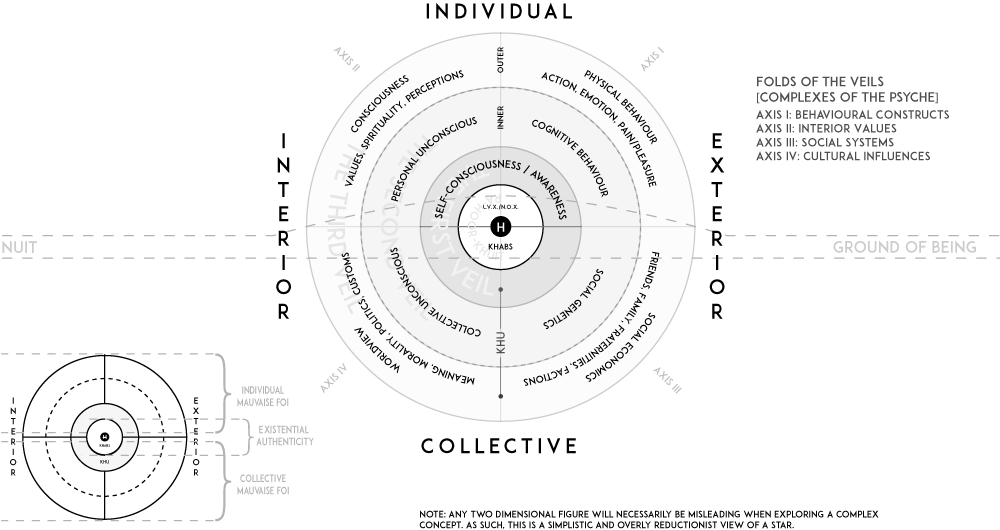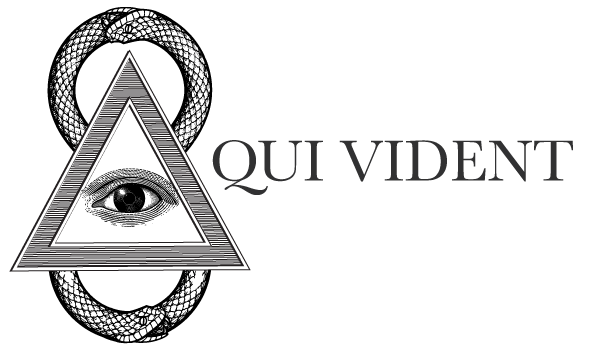Part II: Systematic Theology
Prolegomena
Chapter 1: Theology Proper
Chapter 2: Hierology
Chapter 3: Cosmology
Chapter 4: Anthropology
Chapter 5: Soteriology
Chapter 6: Ecclesiology
Chapter 7: Teleology
Chapter 8: Eschatology
Anthropology
[introduction needed]
Where liberty defines the boundaries of the Law and love is the underlying gravity of the Law, life is the manifested existence of the Law that shines its light on every corner of human endeavor.
Cartography of a Star (Alethiological Model)
The alethiological (cartography) model is predicated on the assumption of a necessary foundation for personal initiation (and as a jump point for a theoretical orientation for psychology as informed by the Law of Thelema) and for the Great Work as illuminated by Crowley when he wrote, "Let him, before beginning his Work, endeavour to map out his own being …".[1] This may be one of the most important—and overlooked—dictates for starting any spiritual endeavor. How can we know we are even capable of the journey if we are unsure of what capabilities we possess in the first place?
The alethiological (cartography) model takes the four validity domains, builds on the model of Thelemic Cosmology (TCM), and expands them further into our personal and collective space while delineating the features of an ontological taxonomy that satisfies the doctrinal constitution of a Star.

Folds of the Veils of Manifestation / Complexes of the Psyche
What the Book of the Law calls the Khu, we can understand readily as the veils of manifestation or, in more psychological terms, the complexes of the psyche. However, rather than settling with Freud's ideas of complexes being mere subconscious hangups, the alethiological (cartography) model expands on similar concepts throughout all four validity domains in relation to the Star itself via a modified use of Wilber's AQAL modal.[2] Each of these axes has an outside and inside element.
Each of these could take up a whole essay or chapter of a book to delve into the intricacies of each quadrant, but only a brief review is offered here. Future presentations would provide further explanation into each of these from both the standpoint of the Great Work and an approach to a theoretical orientation for Thelemic Psychology.
Behavioral Constructs Objective—Individual Exterior
This is that Upper Right quadrant on the Cartography diagram. In this case, the outside is all about physical behavior, actions, emotions, pain and pleasure, &c. These are physical and biological aspects of the individual that we can experience and measure. On the inside, there is cognitive behavior, but this is the realm of, for instance, what we can see when we take brain scans. We are still looking at what we can measure, what we can quantify in some way.
Interior Values Subjective—Individual Interior
This is the Upper-Left quadrant of consciousness in the sense of outside awareness ("awake-ness"). This is different from that internal mechanism of self-awareness. Here we find our personal values, spirituality, and even our perceptions of the world around us. On the inside, we're looking at our own personal unconsciousness or altered states of consciousness (sleep, dreaming, meditation, hallucinations, &c).
Social Systems Interobjective—Collective Exterior
These are our social connections and frameworks, the social economics of family, friends, fraternities, and factions. This Lower-Right quadrant is the structural makeup of our lives and interactions that shape up whether we understand them or not. The inside aspect of this quadrant is what we might call social genetics, that which generally underlies all instances of a particular structure.
Cultural Influences Intersubjective—Collective Interior
All of our cultural influences are here from our inherited worldview to our search for meaning, our understanding of morality and even our political views (politics, as in parties and structures, fall under those Social Systems of influence). The inside aspect of this Lower-Left quadrant is our collective unconscious.
Further on the Interior Construction of the Star
There are two more aspects of this diagram of importance. The center core [Hadit] and Khabs are identified as existential authenticity and the Khu is labelled with both the individual and collective mauvaise foi. Thelema expresses the ontological tension between resistance [Hadit] and participation [Nuit], the conflict and resolution between existential authenticity and the complexes defined by the multiple veils of existence built up from both individual and collective mauvaise foi (Fr., bad faith).
Existential Authenticity — True Will
This central core, and more specifically the Khabs, is that piece of ourselves that is our Authentic Self, or our Silent/True Self. It is known by several different terms, but authentic is what I think expresses it best. When we talk about True Will in terms offered by Crowley, we find that he's always talking about the purpose or the direction our lives manifest when we have an intimate knowledge and understanding of our deepest nature. We are always pushed by it, but it is not until we fully grasp that authenticity are we able to truly be at peace with that interior drive (Destiny) and wholly enraptured by it to press forward in full knowledge and conversation of the Will.
Mauvaise Foi (Individual and Collective)
Mauvaise foi means "bad faith." It is a borrowed existentialist term that I have taken a bit out of context but I think fits here smoothly. Bad faith [or mauvaise foi] is a philosophical concept utilized by existentialist philosophers Simone de Beauvoir and Jean-Paul Sartre to describe the phenomenon in which human beings, under pressure from social forces, adopt false values and disown their innate freedom, hence acting inauthentically. It is closely related to the concepts of self-deception and resentment.
Each of the aspects of the Khu, the four quadrants, the veils of manifestation both individually and collectively, are that which muddy up our view of the Khabs. Mauvaise foi is defined, generally, as "failure to exercise integrity and autonomy in one's basic life choices." We can see this in each of those quadrants and how such a failure would not only be the addition to those complexes which keep us from that sense of and experience with authenticity. Clearing the Khu, resolving the complexes, the mauvaise foi, is the explicit nature of the Great Work.
Attribution
No part of this publication may be used or redistributed for any purpose without the express prior written consent of the author.
Canons of Thelemic Philosophy & Religion © 1996-2024 by Qui Vident.

Comments
If you wish to comment about the materials here, feedback is welcome. Feel free to email questions, comments, and concerns regarding the Canons to curate@quivident.co.